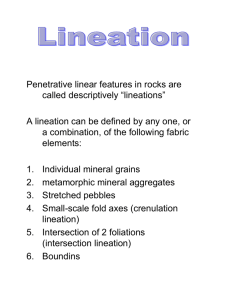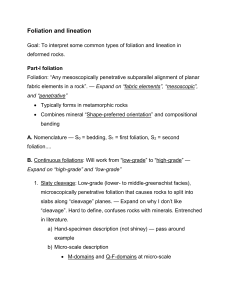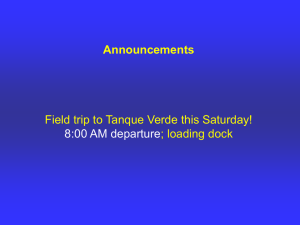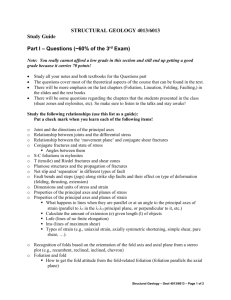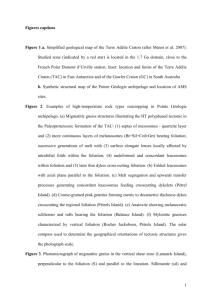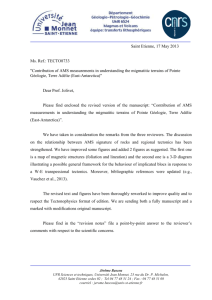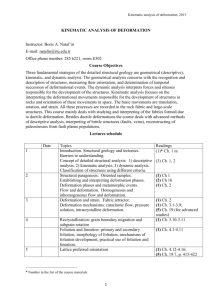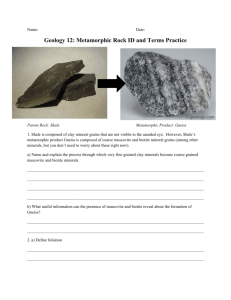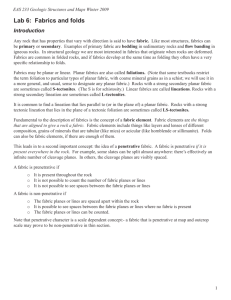Lineation (Fig
advertisement
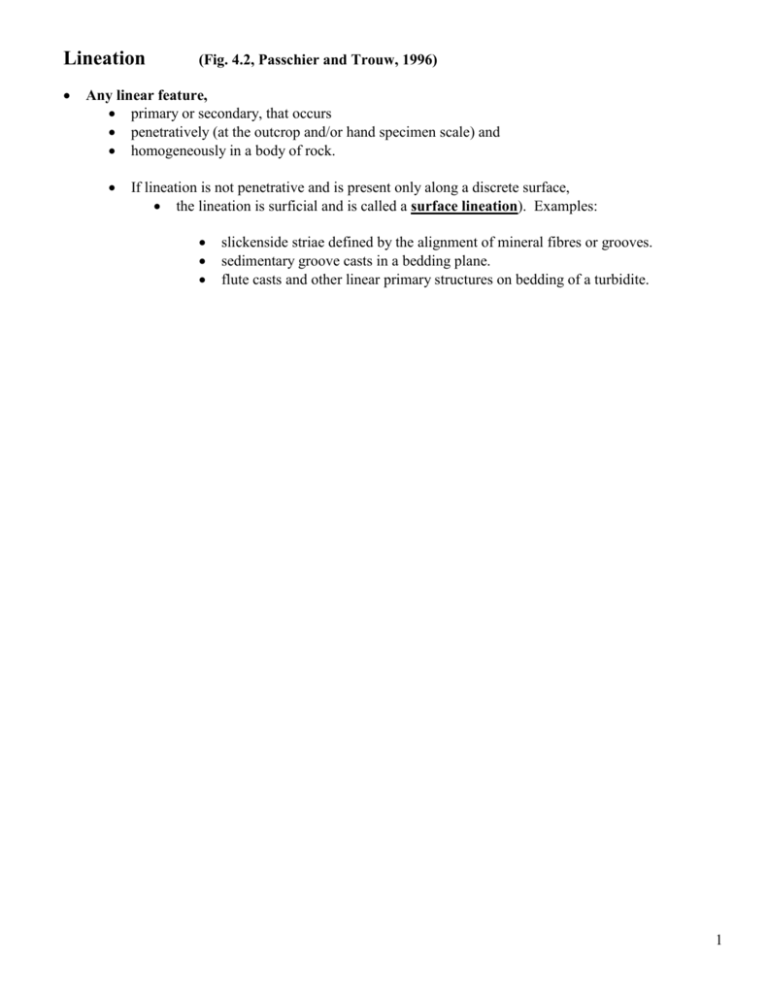
Lineation (Fig. 4.2, Passchier and Trouw, 1996) Any linear feature, primary or secondary, that occurs penetratively (at the outcrop and/or hand specimen scale) and homogeneously in a body of rock. If lineation is not penetrative and is present only along a discrete surface, the lineation is surficial and is called a surface lineation). Examples: slickenside striae defined by the alignment of mineral fibres or grooves. sedimentary groove casts in a bedding plane. flute casts and other linear primary structures on bedding of a turbidite. 1 Types of Lineation Intersection lineation - Formed by intersecting foliations, for example: (bxf), or (SoxS1) - Bedding intersecting a foliation; (reads: bedding cross foliation) If the foliation is axial planar, then the (bxf) defines the fold axis. If the foliation is a slaty cleavage, then (bxc) is the fold axis. (S1xS2) - A younger foliation S2 intersecting an earlier foliation S1). Pencil lineation - rock cleaves parallel to both foliations producing elongate rhombic prisms or “pencils”. Crenulation lineation Defined by the alignment of hingelines of pervasive microfolds in a foliation plane. . (S1xS2) - A younger crenulation foliation S2 intersecting an earlier foliation S1. 2 Stretching lineation Defined by deformed, constricted (i.e., elongated) Grains of minerals such as quartz (that commonly are equidimensional). Aggregates of equidimensional grains. Pebbles in a deformed conglomerate. Forms by crystal plastic deformation. Mineral lineation - Defined by the preferred orientation of: Euhedral or subhedral long (not because they are deformed and elongated) mineral grains such as amphibole, tourmaline, and sillmanite. Planar minerals such as micas that share a common axis. The alignment of the elongate minerals may be due to: 1. Passive rotation toward a principal strain direction during progressive deformation, 2. Growth, i.e., directional crystallization parallel to foliation and 1. Comminution and rotation of larger clasts may also produce alignment of grains in cataclasites during cataclastic flow. Mineral lineations commonly occur in the: plane of a metamorphic foliation shear surfaces mylonitic C-foliation Pressure shadow Is a kind of mineral lineation where new minerals (e.g., quartz, calcite) precipitate (crystallize out of a solution) on the contact between (i.e., on either sides of ): an earlier stiff mineral inclusion mineral aggregate, or grain (e.g., pyrite) and its less competent matrix, producing an elongate structure on a foliation. The fibres are parallel to the direction of stretching. Pressure shadow is a growth-related mineral lineation and forms by preferential growth. 3 Linear Structures: Large, parallel alignment of elements at the outcrop scale, for example: stretched pebbles, mullions, pencil structure, boudin. Discrete linear structure Formed by the deformation of discrete objects such as: stretched ooids pebbles, fossils reduction spots. If the objects where originally spherical, then the ellipsoidal grains give the strain ratio and orientation of the strain ellipsoid (or ellipse in 2D). 4 Boudins Sausage-shaped segments of extended competent layers surrounded by less competent matrix. Linear segments of a layer that has been pulled apart along periodically-spaced lines of separation called boudin lines (necks). pinch-and-swell structure chocolate tablet structure If ductility contrast is large, boudins will be subangular with rectangular forms. As ductility contrast diminishes, boudins become more lens-shaped in profile. Mullion Rod Linear fluted structures developed within a rock or at lihologic interfaces.(look like mullions in Gothic cathedrals) Mullion cross section (few cm in dimension) has: convex surfaces with intervening cusps. or by alternating convex and concave surfaces. Mullion length is indefinite. When intense deformation detaches the limbs of folds such as occurs during fold transposition, only fold hinges may be left in the rock. These hinges are called rod. Rodding typically occurs: In a multilayer composed of phyllite or schist and quartzite. The quartz layers are relatively rigid and define visible folds. The limbs of these quartz layers may become severely pinched out, and quartz may flow in the fold hinge zone to form a rod. 5 Slip lineations Form on surfaces on which there has been sliding, e.g., a fault plane on the interface of beds in a flexural slip fold. Are a type of surface lineation. Trend parallel to the sliding direction on the faulted or folded surface. Two basic types of slip lineation: 1. Groove lineations - form by plowing of surface irregularities due to friction. 2. Fiber lineations - form when vein mineral fibres precipitate along a sliding surface. 6 Types of Tectonites and Strains Tectonite: Rock with pervasive foliation and/or lineation deformed ductiley by solid-state microscopic crystal plasticity or cataclastic flow. Flattening: Produces S-tectonite. Spheres are deformed into oblate (pancake-shaped) strain ellipsoids: S1 = S2 > S3 Constriction Produces L-tectonite Spheres are deformed into prolate (cigar-shaped) strain ellipsoids (cigar): S1 > S2 = S3 Plane Strain May produce LS-tectonite Form in non-coaxial strain conditions; stretching in one direction is compensated by flattening in another; S1 > S2 > S3 assume S2 = 1. Lineations are commonly associated with foliation (in LS tectonites). In this case, the relative age of the lineation and foliation must be established. If of the same age, the lineation may furnish information on the direction of tectonic transport (e.g., shear direction on a mylonitic C-foliation). This requires cutting oriented thin section. If the rock only possesses lineation, it is called a L tectonite If the rock only has foliation, it is called S tectonite Like foliation, lineation may be: primary (linear tool marks, flute cast, ripple marks on turbidite bedding) secondary (e.g., crenulation). 7
